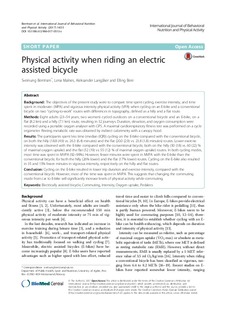| dc.description.abstract | Background: The objectives of the present study were to compare time spent cycling, exercise intensity, and time spent in moderate- (MPA) and vigorous intensity physical activity (VPA) when cycling on an E-bike and a conventional bicycle on two “cycling-to-work” routes with differences in topography, defined as a hilly and a flat route.
Methods: Eight adults (23–54 years, two women) cycled outdoors on a conventional bicycle and an E-bike, on a flat (8.2 km) and a hilly (7.1 km) route, resulting in 32 journeys. Duration, elevation, and oxygen consumption were recorded using a portable oxygen analyser with GPS. A maximal cardiorespiratory fitness test was performed on a cycle ergometer. Resting metabolic rate was obtained by indirect calorimetry with a canopy hood.
Results: The participants spent less time (median (IQR)) cycling on the E-bike compared with the conventional bicycle, on both the hilly (18.8 (4.9) vs. 26.3 (6.4) minutes) and the flat (20.0 (2.9) vs. 23.8 (1.8) minutes) routes. Lower exercise intensity was observed with the E-bike compared with the conventional bicycle, both on the hilly (50 (18) vs. 60 (22) % of maximal oxygen uptake) and the flat (52 (19) vs. 55 (12) % of maximal oxygen uptake) routes. In both cycling modes, most time was spent in MVPA (92–99%). However, fewer minutes were spent in MVPA with the E-bike than the conventional bicycle, for both the hilly (26% lower) and the flat (17% lower) routes. Cycling on the E-bike also resulted in 35 and 15% fewer minutes in vigorous intensity, respectively on the hilly and flat routes.
Conclusion: Cycling on the E-bike resulted in lower trip duration and exercise intensity, compared with the conventional bicycle. However, most of the time was spent in MVPA. This suggests that changing the commuting mode from car to E-bike will significantly increase levels of physical activity while commuting.
Keywords: Electrically assisted bicycle, Commuting, Intensity, Oxygen uptake, Pedalecs | nb_NO |

